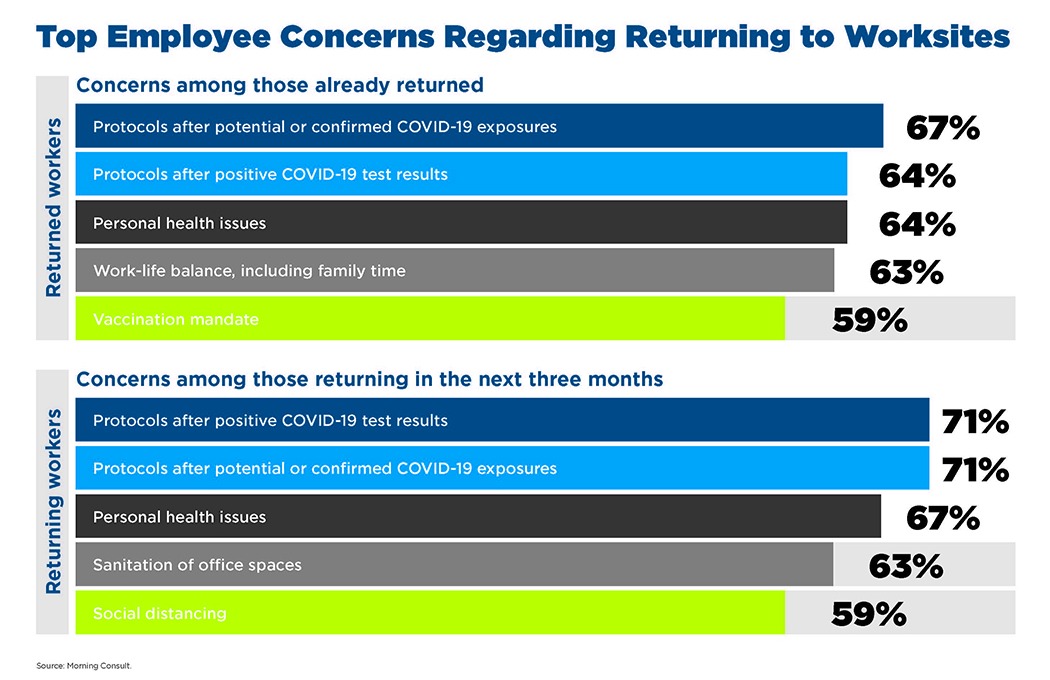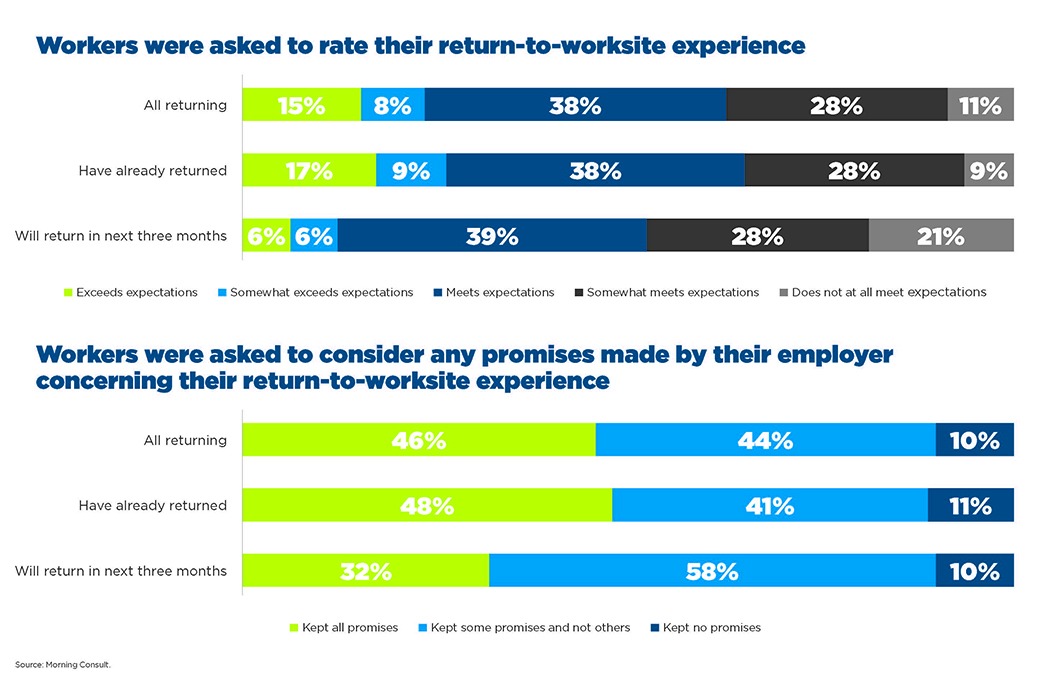In the age of COVID-19, the concept of “business as usual” has been forever changed.

In the age of COVID-19, the concept of “business as usual” has been forever changed.
The past two years of conducting business during the pandemic have been chaotic for organizations nationwide. Right at the outset of COVID-19, companies had to overhaul their entire business practices to enable remote work arrangements with very little notice. Reopening worksites has been equally challenging. Surges of COVID-19 variants delayed early plans, which led to many employees discovering different ways to get work done than what they had traditionally done at the office. Many employers are taking notice that they cannot simply go back to the way things were before the pandemic, so they need to revamp their businesses again in order to resume in-person work as the threat of COVID-19 begins to fade.
Today, many employers are struggling with implementing return-to-work plans that meet employee expectations. Less than half of returning employees feel that their employers have kept all of the promises made regarding reopening their worksites, according to latest research by decision intelligence company Morning Consult. What’s more, while more than two-thirds (68%) of workers are comfortable returning to the office, many are still worried about their personal health and safety. They are also concerned about losing the work-life balance that had improved greatly while working from home.
These findings are from Morning Consult’s recent survey of employees who have returned or are soon scheduled to return to their place of work. Below, we explore key aspects of the surveyed workers’ satisfaction and concerns with returning to their worksites — information that can help guide organizations to effectively transition their employees back to in-person work.
Personal Health and Safety Are the Top Concerns, Followed by Work-Life Balance
Employees were asked how concerned, if at all, they were about components of their return-to-work experience. The top five responses among both returned and returning workers (any, not just office workers) included concerns for their personal health and about COVID-19 safety protocols. Workers who will soon return were more concerned about sanitation and social distancing in the office than vaccination mandates.
In addition, workers who have already returned to worksites expressed a concern of maintaining work-life balance and family time. These are important for relieving employee stress and burnout, which have been growing workplace concerns during the pandemic.
Employee Expectations of Return-to-Work Plans Still Need to Be Managed, Especially for Those Who Have Not Yet Returned
Overall, most workers felt satisfied with how their employers have addressed their return-to-work concerns. However, employees who are about to return reported lower levels of satisfaction with their employer’s efforts compared to workers who were already back at the worksite. In addition, roughly half of returning employees feel that their employers were not meeting their expectations, and less than half of workers believe their employers have kept all of their promises related to reopening the worksite.
These findings suggest that employer communications regarding return-to-work plans may not have done enough to convince returning workers that employers will ensure a good transition.
Easing Employee Concerns About Going Back to In-Person Work
Employers can help ease concerns of transitioning back to the worksite by engaging employees and fostering individual well-being. Here are five ways:
1. Stay connected. Ongoing communication will help employees better understand the plans and policies for returning to work. This communication should be two-way, allowing opportunities for employees to express any concerns or suggestions regarding transition plans, which can help increase workforce alignment. Managers need to maintain regular team interactions involving all in-person or still-remote workers, and should also frequently check in with team members to gauge individual comfort levels and better understand how they can best support their employees.
2. Report progress. Communications should regularly share any metrics of how the return-to-work experience is going, as well as any action plans if improvements are needed.
3. Stick to the plan. Employers need to fulfill all promises made regarding transition plans, as well as be consistent in enforcing all return-to-work policies. Be sure to clearly communicate any changes or exceptions to these policies, as well as the reasons for them, so there is no misunderstanding.
4. Promote work-life balance. This can be done by offering flexible schedules, encouraging the use of paid time off, offering mental health or well-being days, and establishing “blackout periods” in which workers would not be expected to answer e-mails or their phone. Caregiving is also a key challenge for a number of workers, so offering and promoting caregiver back-up and child and elder care resources would be helpful. Encourage managers to model these work-life practices so employees would feel assured in maintaining this balance for themselves.
5. Foster a culture of well-being. Moving back to the worksite is likely to create some turbulence. Business leaders who can support individual well-being can help ease the transition back to the worksite. Senior executives can lead by example by establishing and engaging in on-site health and wellness programs, sharing their own success stories while regularly communicating the value of health and well-being across the organization. It is critical that the business encompass a holistic view of physical and mental health, which includes destigmatizing mental health conditions (such as stress, isolation and depression) and increasing acceptance in seeking help for such issues. Make sure employees know they have resources available to them for getting any additional support they may need, such as counseling via an employee assistance program and more comprehensive behavioral health care through the company’s health plan, including options to connect with a mental health professional virtually. Employees with Cigna health plan coverage can access their benefits at myCigna.com.
Consider a Policy of No Return
Many workers who have not yet returned to the worksite actually benefit from remote work arrangements. Over half (56%) of office employees surveyed enjoy working remotely, and 51% felt that remote work makes them more productive on the job. In addition, 62% of respondents said they were more likely to apply for a job if they offer an option to work remotely, even after the pandemic is over.
As happy and productive workers are essential for successful business, organizations should consider policies that allow for remote (or partially remote) work arrangements for employees who want them, if feasible.
Employers continue to play a critical role in supporting the health and well-being of their employees as they move toward post-pandemic work arrangements. Businesses that understand how employees feel about returning to work, and have clear policies that address health and safety concerns, will have greater success of getting the most from their workforce during this transition.
All findings in this article are from an analysis by Morning Consult of data from its “Return to Normal” weekly survey of 400 remote office workers in the United States, with custom questions from their daily omnibus of an additional 760 individuals who were working remotely or were furloughed from work during the pandemic, but have returned or will be returning to their workplace within the next three months. These questions were asked in February 2022, and responses were weighted based on census estimates for age, race/ethnicity, gender, education, and region.

Related Content: The Future of Work is Hybrid, Rooted in Technology and Employee-Centric Culture
The COVID-19 pandemic has changed everything about life as we know it, including what employees have come to expect from their employers. Cigna CHRO Cindy Ryan shares her POV on the return to work and how companies can meet employee needs and expectations.

